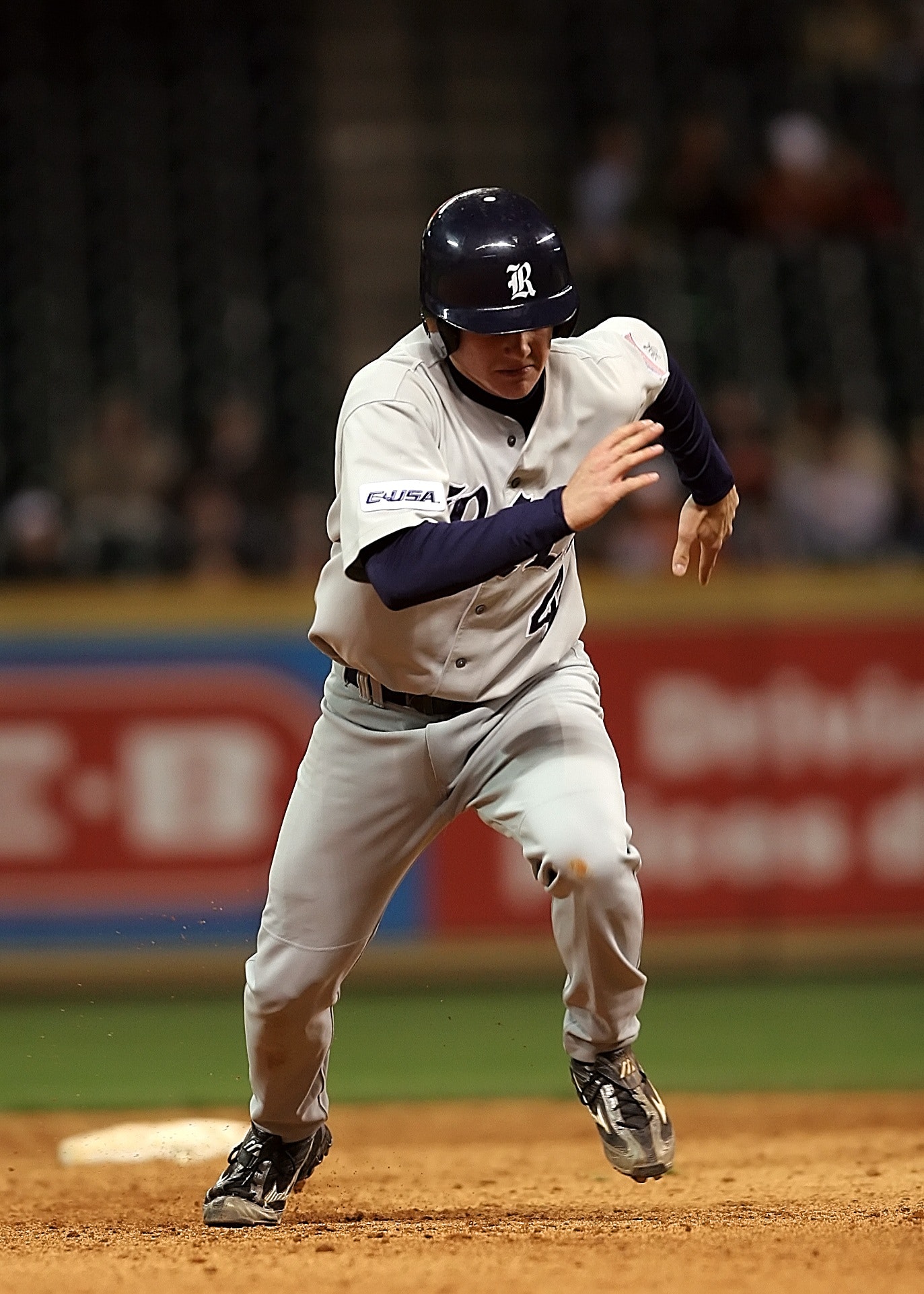 This article will help define the difference in the throwing mechanics of pitchers to position players. It will also explain the key physical differences that make up the pitcher and the position player.
This article will help define the difference in the throwing mechanics of pitchers to position players. It will also explain the key physical differences that make up the pitcher and the position player.
The reason for this article is that I have received thousands of requests from position players for me to develop a velocity program for them. They have all heard of the success of the 3X Pitching Velocity Program and now they want this level of information designed for their position. I have decided to take on this task being that throwing mechanics and training the throwing athlete are not that much more different between the pitcher and the position player.
In this article, I will give you my research and expertise on the mechanical differences between pitching to throwing for the position player. I will then show the science and what they are documenting differently when it comes to the throwing mechanics and the physical differences between the position player and the pitcher. I will also give you a look into the 2X Velocity Throwing Program for the position player to show you how we train position players' throwing velocity as opposed to pitching velocity.
Position Player to Pitcher Throwing Mechanics
The foundation of good throwing mechanics does not change between the positions. This means 3X Pitching is very relevant for all position players. Just look at the career of Rick Ankiel. He transitioned from a hard-throwing pitcher to a hard-throwing outfielder. Just search [Rick Ankiel] on youtube and you will find many a video of him throwing a runner out like the video below.
The difference between the pitcher's throwing mechanics to the position player that needs to be explained is how the athlete changes from throwing on the mound in a static position to throwing from the flat ground in a dynamic movement. This is truly what separates the two throwing mechanics.
When on the mound, moving downhill from the rubber, the pitcher must use a full stride to generate as much power as possible into the front foot strike to deliver a high-velocity fastball. When throwing from the outfield the position player will come close to a full stride with as much momentum as possible generated from the run toward the ball. The reason for this long stride and added momentum from the run is that outfielders make the majority of max effort throws to cover the longest distance of throws on the baseball field. When throwing from the infield the distance is short so the max effort isn't always needed. The infielder doesn't need to generate a long stride length to enhance force production, he has the added momentum from the movement to the ball to transfer into the ball speed. It is important for the infielder to get rid of the ball as quickly as possible to prevent having to make the max effort throw with a longer stride.
The critical components of 3X Pitching that occur when peaking ground reaction forces through a linear force vector during the stride into front foot strike and then transferring this force production up into pitch release remain the same for all position players. This also includes optimal hip-to-shoulder separation into early internal rotation. The key difference mechanically is the modification of 3X or triple extension. 3X becomes more of a 2X when moving off of the mound onto flat ground. This is because 3X is not needed when you can build momentum with a run into front foot strike. 2X or ankle and hip flexor extension of the drive leg is all you need. The ankle extension will be enough to peak ground reaction forces with the added momentum from the run to the ball and the hip flexor extension will be enough to initiate the hip rotation following the peak ground reaction forces. You can learn about all of these position-player mechanical throwing components in the 2X Mechanics Guides.
Position Player to Pitcher Throwing Science
I searched the science for any case studies defining the differences between the position player and the pitcher when it comes to throwing and I found five case studies with some interesting data.
The first case study called, Relationship between gluteal muscle activation and upper extremity kinematics and kinetics in softball position players, found that with softball position players the energy mainly generated for the throw comes from the glute and scaps. Here are the results from the study:
To position for font contact (FC), the throwing side gluteus maximus was most active as it was temporarily in a position of single leg support while propelling the body forward. From FC to maximum external rotation (MER), the throwing side gluteus maximus and medius and non-throwing gluteus maximus displayed over 100 % MVIC indicating activation while maintaining pelvic support. Often in dynamic movements muscle activations will display over 100 % MVIC indicating that the muscles are performing outside of the norms of an isometric contraction. From MER, beginning of the acceleration phase of throwing, all gluteal musculature exhibited more than 100 % MVIC in providing pelvic support as well as transfer of energy up the kinetic chain from the proximal lower extremity to the more distal upper extremity and on to ball release (1).
The study also found that the glute not only generates most of the force in the body to apply to ball velocity but that it stabilizes the lumbopelvic-hip complex which stabilizes the scaps to support an increase in arm speed.
A more stable pelvis allows for greater energy transferred and less energy that needs to be generated by the upper extremity. The contralateral relationship of non-throwing pelvic stabilizer and throwing elbow are indicative of the neuromuscular loop and the activation of the contralateral hip in attempt to get full humeral elevation
At ball release (BR), trunk flexion and rotation both had a positive relationship with shoulder moments at maximum internal rotation (MIR) (r = 0.69, r = 0.82, respectively) supporting previous literature, which has suggested that the kinematic actions of the pelvis and trunk are strongly related to the actions of the shoulder during pitching
Normal shoulder movement is achieved through a stable lumbopelvic-hip complex and scapula. Thus, the pelvis must provide a stable platform for the scapula and the scapula provide a stable platform for the shoulder. Essentially, allowing the musculature of the lumbopelvic-hip complex to initiate shoulder movement (1)
It is intriguing that the glute activity of position players is in high demand because another study called, Functional hip characteristics of baseball pitchers and position players, found that the glute activity of pitchers was less than position players. This added glute strength could be needed to stabilize the legs and core due to the added momentum from the movement toward the ball with position players. Here was the result of this study:
Our results demonstrate that pitchers exhibit less gluteus medius strength in the trail leg than do position players (4).
They also discovered another difference between pitchers and position players when it comes to the legs and core.
Our results indicate that position players have significantly more hip internal rotation ROM of the trail side compared with pitchers, although this increase may not be clinically significant (effect size = .53) (4).
It is eye-opening to learn from these two studies that position players may have more leg strength and more hip mobility than pitchers. It is also important to note that glute strength or power is critical for the position player to increase throwing velocity.
Three more interesting studies comparing the arm path and function or dysfunction between a position player and pitcher found that pitchers had more shoulder range of motion (ROM) and less scapular upward rotation which are both red flags for more arm injury. The study called, Quantitative assessment of glenohumeral translation in baseball players: a comparison of pitchers versus nonpitching athletes and Shoulder motion and laxity in professional baseball players discovered increased ROM for the pitcher.
Bigliani et al examined the range of motion of 148 professional players. They reported that the pitchers’ external rotation at 90° of abduction averaged 118° (range, 95°-145°) in the dominant shoulders, whereas the position players’ dominant shoulders aver- aged 108° (range, 80°-125°).3 This finding is similar to the current study’s results (5).
We reported 110° of external rotation in the pitchers’ throwing arms as compared with 100° of external rotation in the position players’ dominant arms; both studies showed a 10° increase in external rotation of the dominant arms of pitchers versus position play- ers (3).
Here is the actual table of data from the first case study showing the ROM differences in the arms of the position players and pitchers.
The last case study cited in this article called, Differences in scapular upward rotation between baseball pitchers and position players, found that the scapular movements between the position player and pitcher is also different. Here are the results from this study:
The results of this study emphasize the decreased scapular upward rotation among baseball pitchers when compared with position players.
As such, decreased activation and strength of the lower, middle, and upper trapezius as well as the serratus anterior have been shown to significantly limit the amount of upward scapular rotation available.
These previous investigations and hypotheses emphasize the importance of early identification of lost scapular upward rotation to limit soft tissue damage. The results of the current study may partially explain the increased prevalence of shoulder injury among pitchers compared with position players (2).
It is now safe two say, with the data recorded from these last three case studies that excessive joint laxity and upper back weakness are common more among pitchers than position players and that maintaining a strong back and core to support shoulder strength and health is critical to both the position player and the pitcher.
The 2X Throwing Velocity Program
 Once again science teaches baseball that strength is critical for both performance and injury prevention and mobility can be a double-edged sword for all positions. The 2X Velocity Throwing Program just like the 3X Pitching Velocity Program is formatted in the same way. It includes the bio-mechanics with the drill-based throwing program, the Olympic Style strength and conditioning program specific for position players, and the anaerobic conditioning program specific for position players.
Once again science teaches baseball that strength is critical for both performance and injury prevention and mobility can be a double-edged sword for all positions. The 2X Velocity Throwing Program just like the 3X Pitching Velocity Program is formatted in the same way. It includes the bio-mechanics with the drill-based throwing program, the Olympic Style strength and conditioning program specific for position players, and the anaerobic conditioning program specific for position players.
If you would like to benefit from these revolutionary baseball performance enhancement programs like the 2X Velocity Throwing Program then get started today because the culture of baseball is changing and if you do not step up to the plate and start learning this new science and training to enhance your performance to its full potential then you could be left behind.
Reference
- Oliver GD. - Relationship between gluteal muscle activation and upper extremity kinematics and kinetics in softball position players. - FACSM, ATC Auburn University, Auburn, AL, USA. - Med Biol Eng Comput. 2013 Mar 22.
- Laudner KG, Stanek JM, Meister K. - Differences in scapular upward rotation between baseball pitchers and position players. - Biomechanics Laboratory, School of Kinesiology and Recreation, Illinois State University, Normal, Illinois 61790, USA. - Am J Sports Med. 2007 Dec;35(12):2091-5. Epub 2007 Aug 8.
- Sethi PM, Tibone JE, Lee TQ. - Quantitative assessment of glenohumeral translation in baseball players: a comparison of pitchers versus nonpitching athletes. - Orthopedic and Neurosurgical Associates, Greenwich, Connecticut, USA. - Am J Sports Med. 2004 Oct-Nov;32(7):1711-5.
- Laudner KG, Moore SD, Sipes RC, Meister K. - Functional hip characteristics of baseball pitchers and position players. - Biomechanics Laboratory, School of Kinesiology and Recreation, Illinois State University, Normal, Illinois 61790, USA. - Am J Sports Med. 2010 Feb;38(2):383-7.
- Bigliani LU, Codd TP, Connor PM, et al. - Shoulder motion and laxity in the professional baseball player. - Am J Sports Med. 1997;25:609-613.



Trackbacks/Pingbacks